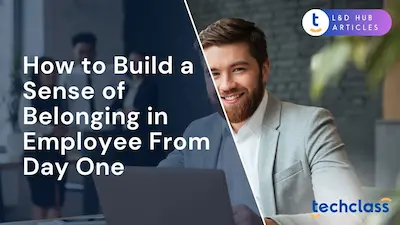
Mobile technology has transformed nearly every aspect of modern life, and workplace training is no exception. In an age where over 80% of the world’s population uses smartphones, organizations are turning to mobile learning (or “m-learning”) to make training more accessible and inclusive than ever. From frontline staff on a shop floor to remote teams spread across time zones, mobile learning enables anytime, anywhere access to training content. This article explores how mobile learning breaks down traditional training barriers and creates a more inclusive learning environment for diverse groups of employees. We will discuss the benefits of mobile learning in enhancing accessibility, supporting various learner needs (including employees with disabilities or busy schedules), and fostering an inclusive culture where no employee is left behind.
Digital learning in organizations has been evolving for years, but the rise of mobile learning is truly a game-changer. Modern employees carry smartphones everywhere, and training delivered via these devices has seen explosive growth. In fact, mobile learning is a rapidly expanding market, valued around $40 billion in 2022 and projected to exceed $100 billion within a few years[^1]. Why such growth? Because mobile learning aligns with how today’s workforce prefers to learn. Research indicates that a majority of corporate learners prefer training delivered on mobile devices due to the convenience of on-the-go access[^1]. Workers increasingly demand training that fits into their busy lives, and mobiles allow them to engage in learning whenever they have a spare moment.
Moreover, mobile learning is addressing the challenge of dwindling attention and time for professional development. The average employee can dedicate only about 24 minutes per week to formal learning amid daily job duties[^3]. In this fast-paced context, learning can feel like a luxury. Mobile learning offers a solution by providing bite-sized, micro-learning modules that employees can complete during short breaks, commutes, or downtime. This just-in-time approach meets modern learners’ needs, limited time but a strong desire for continuous growth. It’s not surprising that organizations implementing mobile training have reported higher course completion rates and faster learning cycles than traditional methods, as employees can finish modules 45% faster on mobile than on desktop on average[^3]. Clearly, mobile learning is not just a trend but a powerful new standard in workplace training.
One of the most significant advantages of mobile learning is how it breaks down accessibility barriers that have long plagued traditional training. In the past, employees needed to be in a classroom or at a computer to participate in training. This inherently excluded those without easy access to a desk, a PC, or a reliable internet connection. Mobile learning changes that paradigm by putting training in the palm of employees’ hands.
Device and Internet Access: Not all workers have laptops or broadband at home – especially those in certain demographics or regions. For example, in the United States a notable segment of young adults (around 20% of 18–29-year-olds) rely entirely on smartphones for their internet access[^4]. If training materials are not mobile-friendly, these employees are effectively locked out of e-learning opportunities. By ensuring all learning content is accessible via mobile (and not just on desktop), organizations remove a major barrier. Even employees with no home computer can complete courses on their phone. In this way, mobile learning equates to equitable access – everyone with a smartphone can participate in training programs on an equal footing.
Anytime, Anywhere Learning: Mobile learning also eliminates barriers of time and location. Traditional in-person workshops or scheduled webinars often conflict with employees’ work shifts or personal responsibilities. In contrast, training delivered through a mobile app or responsive website is available 24/7. Employees can choose when and where to learn – whether it’s during a lunch break, on a train ride home, or while waiting for an appointment. This flexibility is especially valuable for employees who juggle work with caregiving or those pursuing education alongside their job. They might only have small pockets of time to learn, and mobile modules let them maximize those moments. The result is greater inclusion of people who previously couldn’t attend lengthy training sessions. As an added benefit, learning in self-chosen comfortable environments can improve comprehension and reduce the stress associated with rigid training schedules.
Cost and Scalability: From an organizational perspective, mobile learning platforms can often deliver content at scale with lower costs than in-person training. This economic efficiency means companies can afford to roll out training to more employees in more locations. In other words, budget constraints are less likely to force hard choices about who gets training. Everyone from headquarters staff to field workers can be included when training is distributed via mobile at minimal incremental cost. Some companies have even reported significant cost savings (one case study noted a 25% reduction in training costs after shifting to a mobile learning platform), allowing them to reinvest in creating more diverse and extensive learning content[^1]. In short, mobile learning makes broad access both technically and financially feasible, democratizing employee development opportunities across the board.
Perhaps the most dramatic impact of mobile learning on inclusion is seen with frontline or deskless workers. These are employees who do not work at a desk or computer, think retail associates, hospitality staff, factory operators, field technicians, drivers, healthcare workers and more. Remarkably, this group represents about 80% of the global workforce, roughly 2.7 billion people worldwide, who historically have had the least access to corporate training and development[^2]. Traditional e-learning often overlooked these workers because it assumed a desktop environment or consistent screen time that simply isn’t available in their roles.
Mobile learning is a game-changer for the deskless workforce. Equipped with only a smartphone, these employees can now engage with training materials anywhere on the job. Instead of requiring a computer lab or classroom (which might be far removed from their workplace), training reaches them on the shop floor, in the field, or on the road. This “anywhere access” means frontline employees finally have the same development opportunities as their office-based counterparts. For example, a retail sales associate can complete a new product knowledge module on a mobile app during a quiet period on the store floor. A delivery driver can listen to a safety training podcast on their phone between routes. A hospital nurse can review an updated procedure on a tablet during a break. None of these scenarios would be practical with tethered, PC-based training.
Organizations that have embraced mobile learning for frontline staff report impressive outcomes. One luxury retail company launched a campaign titled “Deskless doesn’t mean voiceless” to emphasize that their frontline store employees’ learning needs matter just as much as those of desk workers. By rolling out an intuitive mobile learning app to all retail staff, they saw over 26,000 content views in the very first month as previously disengaged employees eagerly accessed the training materials[^5]. This kind of engagement spike highlights an important truth: frontline workers are hungry for learning when it’s presented in a convenient format. Similarly, large employers with many deskless workers (in industries like hospitality, manufacturing, logistics, etc.) have found mobile learning boosts training participation rates dramatically. In one case, a global retail giant reported a 40% increase in employee training participation after switching to a mobile-first training approach[^1].
By empowering deskless employees with on-demand learning, companies not only improve skills and performance, but also send a powerful message of inclusion. It tells these workers: “We value your growth and we’ll meet you where you are.” This has a side benefit of improving morale and retention. When workers feel invested in and not “left behind,” they are more likely to stay with the company. In essence, mobile learning has opened the door for millions of frontline employees to develop and advance in their careers, helping to close a long-standing gap in workforce development.
Inclusion through training isn’t only about reaching different job roles, it’s also about meeting diverse learner needs and abilities. Every employee has a unique way of learning and may face unique challenges. Mobile learning, when designed thoughtfully, can accommodate a wide range of learning styles, preferences, and accessibility needs in ways traditional training might struggle to do.
Multimedia and Learning Styles: People absorb information differently – some learn best by reading text, others through listening or watching, and some by interactive doing. Mobile learning platforms support a rich mix of media: text articles, short videos, audio clips, quizzes, interactive simulations, games, and more. This variety means training can be delivered in multiple formats to suit different preferences. For instance, a salesperson who is a visual learner might benefit from a video demonstration on their phone, while another who prefers text can read the transcript or an article. Mobile apps often allow easy integration of quizzes and flashcards for those who learn by doing or self-testing. By personalizing content formats, mobile learning ensures no one is disadvantaged because the material was only presented in one rigid way. This inclusive approach acknowledges that one size does not fit all in learning.
Accessible Design for Disabilities: Mobile devices come with a host of built-in accessibility features that, if leveraged, make learning content usable by employees with disabilities. For example, smartphones and tablets typically offer screen readers (for visually impaired users), text-to-speech and voice control, closed captioning for videos, adjustable font sizes, high-contrast display modes, and more. A well-designed mobile learning module can take advantage of these features. An employee with low vision can enlarge text or use a screen reader to hear course content. A deaf or hard-of-hearing employee can turn on captions for instructional videos and fully understand the material. There are also options like haptic feedback or audio cues that can aid learners with different needs. In a traditional classroom or a printed handbook, accommodating such needs might require special sessions or materials; on mobile, it’s often as simple as enabling an option. Ensuring digital accessibility standards (like WCAG guidelines) in mobile content not only avoids excluding those with disabilities but often improves the user experience for everyone. By providing multiple ways to consume information (read, watch, listen, interact), mobile learning supports diverse abilities and learning differences, from dyslexia to hearing impairment to ADHD. It creates a more level playing field where each employee can engage with training in the mode that works best for them.
Self-Pacing and Microlearning: Another inclusive aspect of mobile learning is the ability for learners to control their pace. Traditional group training moves at one speed, which might leave some learners overwhelmed and others bored. On a mobile platform, each person can progress through modules at a comfortable pace – pausing, rewinding, or reviewing content as needed. This self-pacing is particularly beneficial for those who may need extra time to absorb information (perhaps employees learning in a second language or those who have been out of school for a long time). It removes the stigma of “falling behind” since the learning experience is individualized. Additionally, mobile learning often embraces microlearning, breaking content into bite-sized chunks that focus on one concept at a time. Microlearning is proven to enhance understanding and retention, and it’s friendlier for employees who might struggle with concentration or memory. By delivering small, digestible lessons (often 3-5 minutes each), mobile learning keeps learners of varying skill levels engaged and reduces cognitive overload. In practice, this approach might help, say, an employee with a learning disorder like dyslexia take things step-by-step or allow a busy parent to squeeze in quick lessons and not lose track. Overall, the flexibility and adaptability of mobile learning design make it a powerful tool for inclusive education, ensuring that employees of all abilities can succeed in training.
Workplace learning must also bridge generational and cultural gaps, and mobile learning is well suited for this challenge. In many companies today, you might find four generations of employees working side by side, from Baby Boomers nearing retirement to Gen Z newcomers. There’s also an increasing need to train a geographically dispersed, global workforce. Mobile learning contributes to inclusion by engaging these different cohorts on common ground.
Appealing to Younger Generations: Millennials and Gen Z, who now form a large portion of the workforce, are digital natives deeply familiar with smartphones and apps. These generations expect learning to be as engaging as the social media and games they use daily. Mobile learning meets them where they already live – on their phones. By incorporating elements like app-based interactions, swipe/tap navigation, push notifications, and even gamified features (badges, points, leaderboards), mobile training resonates with younger employees. This helps overcome the challenge of disengagement. In fact, studies have found that employees are substantially more motivated to learn when training is delivered via mobile, one survey noted about 70–72% of learners felt increased motivation with mobile training compared to traditional methods[^1][^3]. The familiarity and ease of use of mobile apps contribute to this. Young employees can consume training content in a format analogous to how they consume personal content, making learning feel more natural and enjoyable. This doesn’t exclude older employees, of course, but it ensures that the incoming generations (often the least engaged in conventional training) are actively included and even excited about development opportunities.
User-Friendly for All Ages: While it’s true that the younger workforce loves mobile tech, it’s worth noting that mobile learning can be designed to be user-friendly for older employees as well. Smartphone adoption has grown among older adults globally, for example, 91% of all U.S. adults now own a cell phone, and even those 65+ have high adoption rates[^4]. Many older workers use smartphones to communicate with family, read news, or navigate, so using them for learning is not a huge leap. The key is thoughtful design: clear interfaces, option to increase text size, straightforward navigation, and avoiding assumptions of tech-savviness. When done right, even employees who are less comfortable with technology can find mobile learning intuitive. A simple menu, a clear “start” button for modules, and guided tutorials can help non-digital-natives get onboarded. In some cases, older employees might actually prefer a well-crafted mobile module to a complex computer-based system or thick manuals. The convenience of not needing to travel to a training site or navigate complicated e-learning software can be a relief. Thus, mobile learning has the potential to unify multiple generations on one platform, providing each the support they need to engage.
Global Reach and Multilingual Support: For companies operating across different regions, one inclusion hurdle is providing consistent training to all employees regardless of location. Mobile learning platforms allow a company to roll out the same training content worldwide with relative ease. Employees in Asia, Europe, Africa, and the Americas can all receive the same information via an app update or content push. Importantly, mobile content can often be easily translated or localized. Many platforms support multilingual content delivery, meaning employees can choose their preferred language for the training if the organization provides localized versions. This is immensely helpful for inclusion in a global workforce – it respects cultural and language differences. For example, a compliance training course might be offered in English, Spanish, Mandarin, and Arabic on the mobile app, ensuring employees comprehend it fully in their native language. Even within one country, mobile learning can help bridge literacy or education gaps by incorporating visual and audio elements to explain concepts beyond just text (useful for workers who may have lower reading literacy). Furthermore, push notifications and updates can be timed appropriately for different time zones so that no region is inadvertently neglected. In sum, mobile learning’s scalability and adaptability make it a prime tool for inclusive training across a diverse, global employee base. It breaks the “headquarters-centric” model of training and empowers every employee, everywhere, with the same knowledge and skills.
Mobile learning is more than a technological innovation, it’s a catalyst for inclusion and accessibility in workplace training. By leveraging the ubiquity of mobile devices, organizations can ensure that training and development opportunities truly reach everyone: from the corporate office to the factory floor, from the 21-year-old new hire to the 60-year-old veteran, and from the fully able to those with disabilities. When executed thoughtfully, mobile learning removes long-standing barriers, be it lack of access to equipment, scheduling conflicts, or one-size-fits-all content, that have historically left certain groups of employees behind.
For HR leaders and business owners, embracing mobile learning is an educational and strategic move. It sends a clear message that the company values equity in learning. The benefits are tangible: higher engagement in training, better knowledge retention, and improved performance outcomes across the board. Studies and real-world cases have shown boosted productivity, cost savings, and increased participation when training goes mobile[^1][^3]. But beyond the metrics, the most powerful impact is a culture shift. Employees feel valued and empowered when they can access learning easily and in a way that fits their life. A truly inclusive training program, one that accounts for different roles, abilities, and backgrounds, creates a sense of belonging and fairness that can elevate organizational culture.
As we move into the future, the workforce will only become more diverse and distributed. Mobile learning, with its flexibility and reach, will be an essential part of any forward-thinking learning and development strategy. By putting learning directly into employees’ hands, companies can foster continuous growth and adapt quickly to change, all while ensuring no one is excluded from the journey of learning. In conclusion, mobile learning is not just an e-learning convenience; it is a powerful enabler of accessible, inclusive, and effective training that stands to benefit both employees and employers in our increasingly connected world.
Mobile learning removes barriers like device access, location, and scheduling, allowing employees to participate anytime and anywhere.
It provides these workers with on-demand training via smartphones, enabling participation in learning despite lack of access to desktops or fixed locations.
It offers multimedia content, accessibility features like screen readers, customizable text sizes, and self-paced microlearning to accommodate different needs.
It appeals to digital-native younger employees with engaging, gamified content, while being user-friendly for older workers through thoughtful design and localization.
It enables consistent training across regions with easily translatable content, supports multiple languages, and adapts to cultural and literacy differences.


